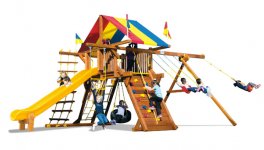Carpe Diem
Member
- Joined
- Mar 18, 2016
- Messages
- 16
Looking for some input and a recommendation. I am about to start refinishing a Rainbow Playset that was given to us from a family member. The playground is made of cedar but has been outside for the past 10 years. A few pieces need replacement but for the most part it seems to be in good shape. The stain has started to peel and needs a good sanding to make smooth again. I need to take it a part to move it so I figure now is the best time to sand and refinish. The playground is big, approximately 14’ x 28’. I have attached a pic for reference.
I am looking for an efficient sander to sand the cedar. I have a ETS 125 but that is to slow for such a large structure.
Is a Rotex to aggressive for Cedar? Would I be better off with an ETS EC?
Looking for the best choice for this project, can you offer your opinion for sanding such a softwood but a large project.
Thanks,
Carpe Diem
I am looking for an efficient sander to sand the cedar. I have a ETS 125 but that is to slow for such a large structure.
Is a Rotex to aggressive for Cedar? Would I be better off with an ETS EC?
Looking for the best choice for this project, can you offer your opinion for sanding such a softwood but a large project.
Thanks,
Carpe Diem

